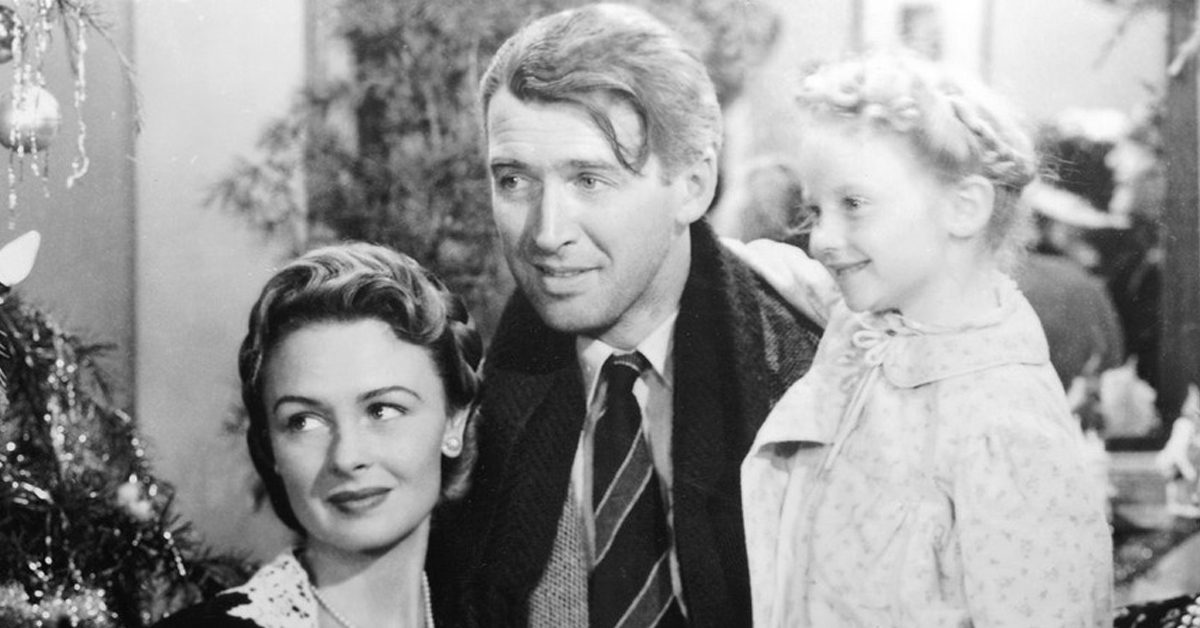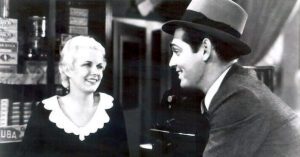The favorite film of both its star, James Stewart, and its director, Frank Capra.
Based on a short story, “The Greatest Gift”, by Philip Van Doren Stern, written in 1939, enclosed with his 1943 Christmas card, published privately, and copyrighted in 1945.
Cary Grant got one of these cards and brought the story to the attention of RKO, where he was under contract. In September of 1945 The Hollywood Reporter announced Grant would star with Gary Cooper in a motion picture adaptation for RKO. But in November the property was sold to the new Liberty Films and Frank Capra as a vehicle for Jimmy Stewart. Neither had made a film since 1941.
Liberty borrowed $1,540,000 from Bank of America to finance production, which was budgeted at $2,362,427. Shooting commenced April 16, 1945 through July 27 at RKO in Hollywood and Culver City, and the RKO Ranch out in Encino. The Charleston contest was filmed at the newly built Beverly Hills High School gym. Watch for Our Gang’s grown star Carl “Alfalfa” Switzer who plays a key part in the pool scene.
With lavish production and a huge overrun, the final negative cost came in at $3,780,000. Final figures on the net loss vary, but estimates start at $500,000 which equates to $6,900,000 in today’s purchasing power of the dollar.
Considered for the female lead was Capra favorite Jean Arthur, but Donna Reed snagged the role instead.
The New York opening was on December 20. In a tactical failure, RKO did not make the picture available at regional exchanges for theaters to book exhibitions until January 7, 1947. Christmas, however, was finished on December 26. This was a Christmas picture. Consequently it lost money. By contrast, Miracle on 34th Street was issued on May 2, 1946 and scored big at the boxoffice.
Reviews were favorable. Five Oscar nominations were announced for Capra, Stewart, editing, sound, and best picture.
The music score was by the Russian composer Dimitri Tiomkin, and why it was not given the Oscar nod remains a mystery. Tiomkin held a doctor of law degree and did win four Academy Awards for other pictures as well as many more Oscar nominations.
Liberty Films was dissolved in 1951. Film assets pledged on the bank loans (not made by “Mr. Potter”) became the property of Bank of America as a consequence of the bankruptcy. These were sold to a TV distributor, National Telefilm Associates (NTA), which became part of the new incarnation of Republic Pictures during the 1980’s.
In 1974, however, NTA had failed to renew the motion picture photoplay copyright, and TV stations worldwide began seasonal programming on a non-exclusive basis because the film had been dedicated into the public domain. It was only then that the public discovered the wonder and charm of It’s A Wonderful Life and embraced the film as a true Christmas classic for the ages. Thus providing the picture a second “wonderful life.”
In 1993, three years after the Rear Window ruling by the Supreme Court, Republic argued that since it was the successor in interest to the underlying story rights, owned property rights to the Capra film negative, and had — most importantly — secured rights to the incidental music score, it had effectively tied down the film and held exclusive exhibition rights on this beloved holiday classic movie. Republic has since been folded into Paramount Pictures.
More recently enterprising film distribution executives who have managed to get their hands on separate preprint elements for the picture portion and the unmixed track components – not easily secured – have remixed the track with a new but inferior incidental music score and then recopyrighted the new content. The result is an inauthentic and disappointing film experience.
One of many great lines in It’s A Wonderful Life: “Dear George: Remember no man is a failure who has friends. Thanks for the wings! Love Clarence.”




